- Colombia: Manufacturing production resumes downtrend while retail sales appear to stagnate
- Peru: May GDP growth at 5.0% for second consecutive month
COLOMBIA: MANUFACTURING PRODUCTION RESUMES DOWNTREND WHILE RETAIL SALES APPEAR TO STAGNATE
On Monday, July 15th, the National Institute of Statistics (DANE) published manufacturing production and retail sales data for May 2024. Manufacturing production fell by -3.6% compared to May 2023 (chart 1), while retail sales registered a contraction of -1.7% y/y.
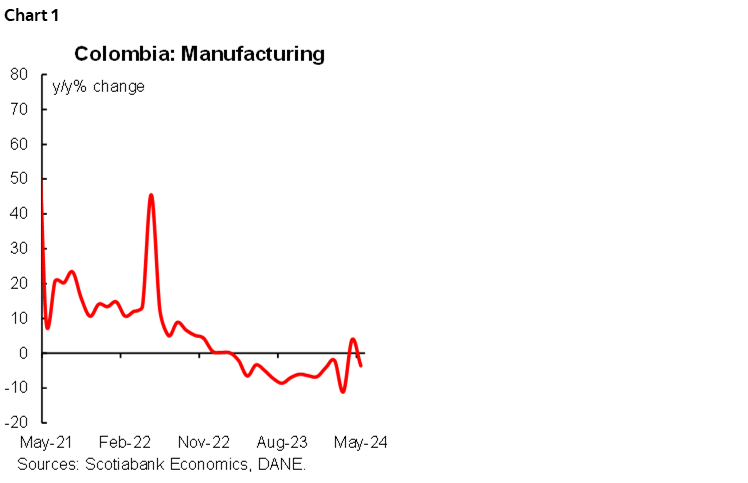
May’s manufacturing production showed that economic activity remains weak (chart 2). The March and April data were volatile due to the statistical effects that arose from the impact of Easter on the number of business days (2024 vs 2023), while cleaner May data shows that the manufacturing sector still does not have a recovery trend. In annual terms, manufacturing production fell -3.6%, with vehicle manufacturing being the activity that registered the greatest contraction (-60.8% y/y), reflecting the low demand and exit of agents in the segment, such as the closure of the Generals Motors plant in the country.
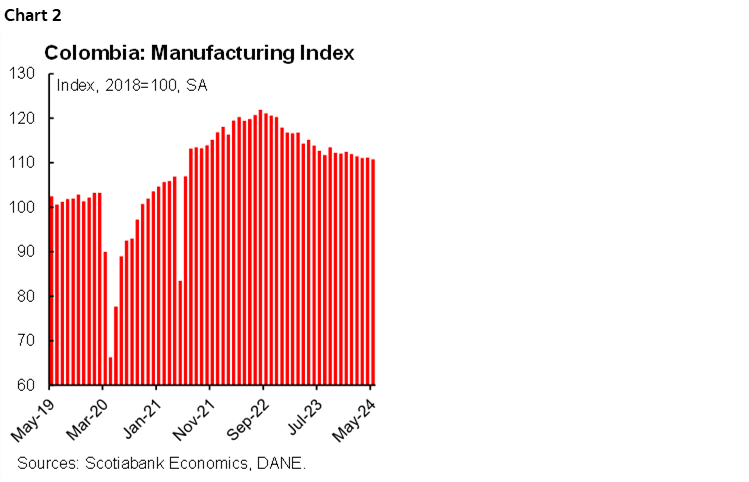
The dynamics of retail sales show a lower household willingness to consume and focused on a so call defensive goods consumption such as food. At the same time, durable goods consumption has been hit by a lower demand. In May, the celebration of Mother’s Day helped the dynamics of sales since in monthly terms it registered a modest growth of 0.78%, however, in annual terms retail sales fell -1.7% (chart 3), reflecting a weak performance in the sale of clothing and other textile products, this being one of the segments that contribute the most to the general result (-0.7 ppts). Products associated with the automotive sector continue to register declines in sales even though the prices of vehicles and parts are at a more favourable level for purchase even with negative inflation in the tradable transportation sector, which as of May was at -5.18% annually. On the positive side, the sale of televisions stands out, which could be associated with advance purchases to view different soccer championships such as the European Championship and the Copa America.
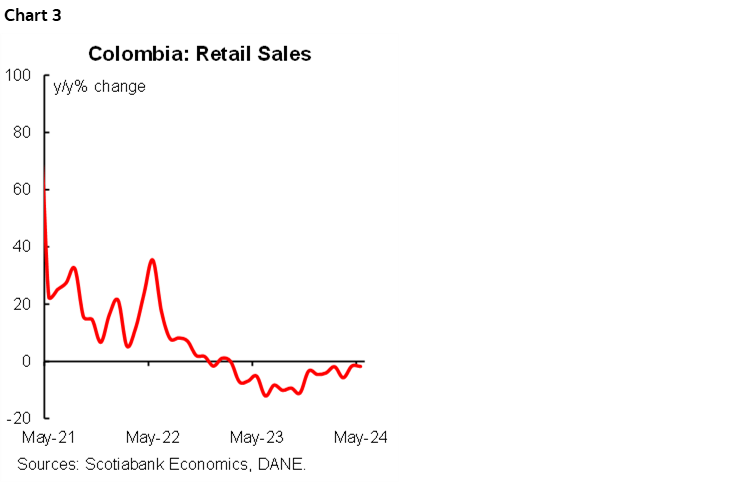
On July 18th, the Economic Monitoring Indicator (ISE) will be published, in which the behaviour of the different sectors can be seen more widely. Although the manufacturing sector and the commercial sector maintain a negative dynamic, the trend would not affect the prospect that BanRep will maintain a cautious stance at the next monetary policy meeting, in which we expect a cut of 50bps that will bring the reference rate to 10.75%.
Highlights:
- Manufacturing production fell 3.6% y/y, showing that the positive result in April was only a seasonal effect. So far this year until May, real production has recorded a contraction of -3.5%. The production of drugs and personal hygiene products has had the best performance, which may be related to climatic phenomena that influence health, generating greater demand for these products. On the negative side, the lower manufacturing of textiles and automobiles stands out, associated with lower sales.
- Retail sales registered a fall of 1.7% annually. The segments that contributed the most to the negative variation were fuel sales (-0.7 ppts), clothing sales (-0.6 ppts), and vehicle sales (-0.5 ppts). In response to a lower willingness to buy on the part of consumers, considering that the cost of credit remains high. However, this would improve as BanRep continues with the flexibility cycle and credit rates become more favourable for the acquisition of durable goods.
- On the positive side, retail sales of other vehicles (public transportation and freight transportation) were the ones that most offset the result, contributing +0.6 ppts, followed by audio and video equipment (televisions) that contributed +0.2 ppts. In addition, the good dynamics that sales of domestic and personal hygiene products have had stand out.
- In marginal terms, retail sales grew 0.78% compared to April. The celebration of Mother’s Day usually influences this behaviour, given an increase in household demand (chart 4).
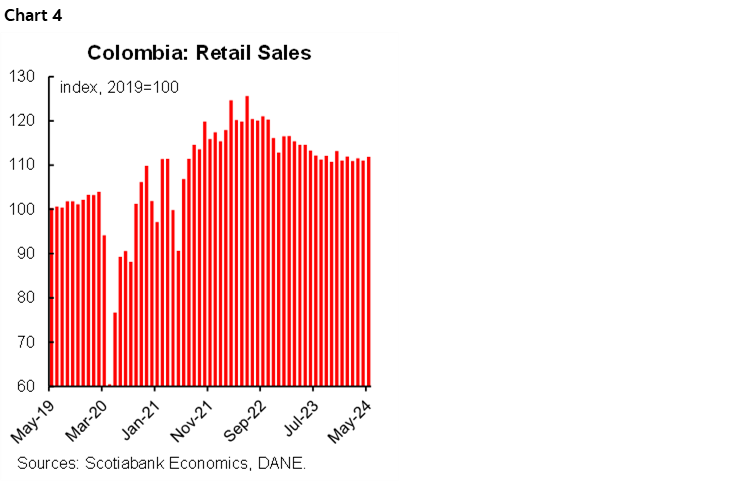
—Sergio Olarte & Daniela Silva
PERU: MAY GDP GROWTH AT 5.0% FOR SECOND CONSECUTIVE MONTH
May’s heartwarming 5.0% GDP growth, y/y, followed a similar 5.3% y/y growth for April (chart 5). There was a difference, however. High GDP growth in April benefited from two extra days due to a calendar shift in the Easter holiday season. Unlike April, there were no calendar anomalies in May, which was a more normal month. May’s figure was, thus, stronger than April’s.
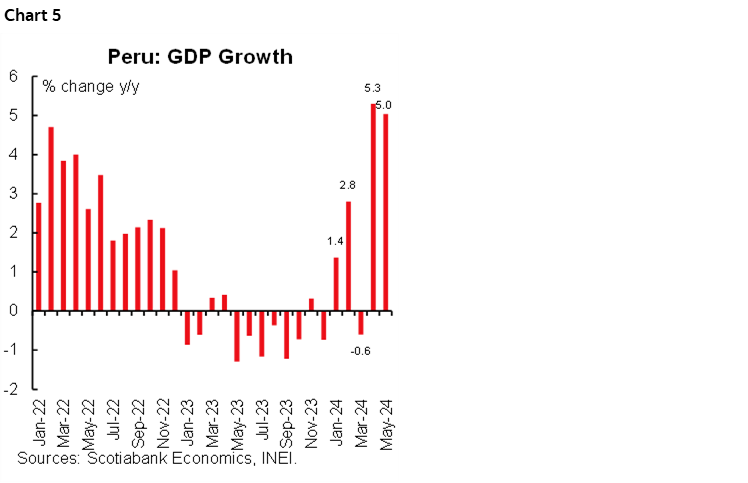
One could get used to 5% growth. Only, it won’t recur easily. Calendar issues aside, what did help boost growth in May was an excellent fishing season in 2024, versus none at all in 2023. Fishing, up 329% y/y directly, and 450% indirectly through fishmeal processing, provided well over one percentage point to growth in May. That will change going forward, as the low base due to 2023’s El Niño wears off.
Given this, if one wished to look at sustainable growth drivers over time, it’s best to focus on sectors that are linked to domestic demand. Here the results are more patchy. Industrial manufacturing was up a soft 1.1% y/y, for instance, while financial services continued to decline in May, -1.1% y/y, and telecom, electricity and commerce fluctuated in a range from nil to 2.1%.
Moreover, month-on-month growth was weak pretty much all around, with the sole exception being mining and oil & gas, up 3.8%.
Among domestic demand linked sectors, only construction GDP rose a healthy 5.5%, although this was linked to public sector spending more than to private sector demand (table 1).
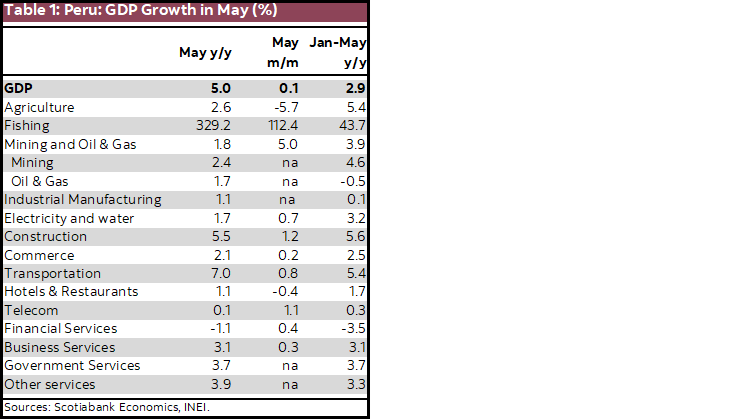
Looking at trends, cumulative growth in the year to May was an encouraging 2.9%. If growth stabilizes in this vicinity, or perhaps a little higher, as it very well could, then we’ll be able to count 2024 as a good year. There are still some notable tailwinds going forward, foremost among these is the pension fund withdrawals. Note that domestic demand in May was still not bolstered by pension fund withdrawals, which should begin having an impact for a few months starting in July. More intriguingly, there is an underlying sensation that things are starting to pick up with some conviction, even if domestic demand growth sectors still do not show it.
As an aside, the BCRP board members no doubt had good information on the May GDP growth number when they decided to maintain the reference rate stable at 5.75%. With growth like this, why hurry in lowering interest rates?
—Guillermo Arbe
DISCLAIMER
This report has been prepared by Scotiabank Economics as a resource for the clients of Scotiabank. Opinions, estimates and projections contained herein are our own as of the date hereof and are subject to change without notice. The information and opinions contained herein have been compiled or arrived at from sources believed reliable but no representation or warranty, express or implied, is made as to their accuracy or completeness. Neither Scotiabank nor any of its officers, directors, partners, employees or affiliates accepts any liability whatsoever for any direct or consequential loss arising from any use of this report or its contents.
These reports are provided to you for informational purposes only. This report is not, and is not constructed as, an offer to sell or solicitation of any offer to buy any financial instrument, nor shall this report be construed as an opinion as to whether you should enter into any swap or trading strategy involving a swap or any other transaction. The information contained in this report is not intended to be, and does not constitute, a recommendation of a swap or trading strategy involving a swap within the meaning of U.S. Commodity Futures Trading Commission Regulation 23.434 and Appendix A thereto. This material is not intended to be individually tailored to your needs or characteristics and should not be viewed as a “call to action” or suggestion that you enter into a swap or trading strategy involving a swap or any other transaction. Scotiabank may engage in transactions in a manner inconsistent with the views discussed this report and may have positions, or be in the process of acquiring or disposing of positions, referred to in this report.
Scotiabank, its affiliates and any of their respective officers, directors and employees may from time to time take positions in currencies, act as managers, co-managers or underwriters of a public offering or act as principals or agents, deal in, own or act as market makers or advisors, brokers or commercial and/or investment bankers in relation to securities or related derivatives. As a result of these actions, Scotiabank may receive remuneration. All Scotiabank products and services are subject to the terms of applicable agreements and local regulations. Officers, directors and employees of Scotiabank and its affiliates may serve as directors of corporations.
Any securities discussed in this report may not be suitable for all investors. Scotiabank recommends that investors independently evaluate any issuer and security discussed in this report, and consult with any advisors they deem necessary prior to making any investment.
This report and all information, opinions and conclusions contained in it are protected by copyright. This information may not be reproduced without the prior express written consent of Scotiabank.
™ Trademark of The Bank of Nova Scotia. Used under license, where applicable.
Scotiabank, together with “Global Banking and Markets”, is a marketing name for the global corporate and investment banking and capital markets businesses of The Bank of Nova Scotia and certain of its affiliates in the countries where they operate, including; Scotiabank Europe plc; Scotiabank (Ireland) Designated Activity Company; Scotiabank Inverlat S.A., Institución de Banca Múltiple, Grupo Financiero Scotiabank Inverlat, Scotia Inverlat Casa de Bolsa, S.A. de C.V., Grupo Financiero Scotiabank Inverlat, Scotia Inverlat Derivados S.A. de C.V. – all members of the Scotiabank group and authorized users of the Scotiabank mark. The Bank of Nova Scotia is incorporated in Canada with limited liability and is authorised and regulated by the Office of the Superintendent of Financial Institutions Canada. The Bank of Nova Scotia is authorized by the UK Prudential Regulation Authority and is subject to regulation by the UK Financial Conduct Authority and limited regulation by the UK Prudential Regulation Authority. Details about the extent of The Bank of Nova Scotia's regulation by the UK Prudential Regulation Authority are available from us on request. Scotiabank Europe plc is authorized by the UK Prudential Regulation Authority and regulated by the UK Financial Conduct Authority and the UK Prudential Regulation Authority.
Scotiabank Inverlat, S.A., Scotia Inverlat Casa de Bolsa, S.A. de C.V, Grupo Financiero Scotiabank Inverlat, and Scotia Inverlat Derivados, S.A. de C.V., are each authorized and regulated by the Mexican financial authorities.
Not all products and services are offered in all jurisdictions. Services described are available in jurisdictions where permitted by law.

